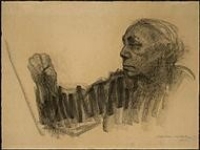The Gallery houses nearly 9,000 examples of European draftsmanship from the eleventh century to the present day, representing artists from every major school of drawing and a wide variety of media including chalks, pastels, graphite, metalpoints, ink, gouache, and watercolor.
The Italian drawings represent a broad spectrum, with works from every key artistic center from the late medieval period to the modern era. Exceptional examples of Italian draftsmanship in the collection include Raphael’s full size cartoon for La Belle Jardinière; a page from Giorgio Vasari's Libro de' Disegni containing ten drawings by Sandro Botticelli, Filippino Lippi and Raffaellino del Garbo; Benvenuto Cellini’s exquisite design for a bronze sculpture of a satyr; a stunning depiction of Christ’s Lamentation in gouache and gold on vellum by Giulio Clovio; and Giovanni Benedetto Castiglione’s extravagant oil sketch of Alexander at the Tomb of Cyrus. The Gallery’s collection is also very strong in works by eighteenth-century Venetian artists known for their facility in the graphic arts: Giovanni Battista Piazzetta, Giovanni Battista Tiepolo and his son Giovanni Domenico Tiepolo, Canaletto, and Giovanni Battista Piranesi.
Holdings of French drawings at the Gallery are especially rich, with several French Renaissance works noteworthy for their rarity; an impressive number of eighteenth-century drawings by important draftsmen such as Antoine Watteau, Jean-Honoré Fragonard, François Boucher, and Gabriel de Saint-Aubin, and several pastels including the Well-Loved Mother by Jean-Baptiste Greuze. A significant collection of drawings by French artists of the modern era present numerous highlights: portraits sensitively rendered in graphite by Jean-Auguste-Dominique Ingres; large caches of drawings by Alphonse Legros, Jean-Louis Forain, and Honoré Daumier; figures from Parisian life and still lifes by Edouard Manet; an extensive array of chalk, charcoal, and pastel studies of dancers, jockeys, and figures by Edgar Degas; watercolors and a sketchbook by Paul Cezanne; many compositional studies by Paul Gauguin; pen and chalk drawings by Vincent van Gogh; an impressive group of oil on carton drawings by Henri de Toulouse-Lautrec; and Henri Matisse’s studies for portraits and odalisques.
A small but varied collection of works by Spanish draftsmen features prime examples by Bartolomé Esteban Murillo, Jusepe de Ribera, Francisco de Goya, and Juan Gris. Drawings by Pablo Picasso include his striking early Self-Portrait (1901) and some of his earliest cubist compositions and collages, most notably the Cup of Coffee (1913).
Works by Northern European artists make up another substantial portion of the National Gallery’s graphics collection. Remarkable drawings by Dutch and Flemish artists include Pieter Bruegel the Elder’s Landscape with Penitence of Saint Jerome; Joris Hoefnagel’s four incomparable volumes of Animalia drawings that record fauna in painstaking detail; Hans Bol’s delicately rendered Winter Landscape with Skaters; Hendrick Goltzius’s large and elegant Head of a Siren; Peter Paul Rubens’s sensuous Pan Reclining; and Anthony van Dyck’s poetic view of Edge of a Wood. Rembrandt van Rijn’s keen powers of observation are illustrated in the Gallery’s collection of his landscape views, studies for biblical subjects, sketches of friends and family members, and in his affable red chalk self-portrait of c. 1637, one of the few Rembrandt self-portrait drawings widely accepted as authentic.
Artists from Germany and German-speaking regions are exceptionally well-represented in the Gallery’s collection, making it the largest and most comprehensive survey of German draftsmanship outside of Europe. The Gallery has nearly a dozen superb drawings by the Renaissance genius Albrecht Dürer, and Adam Elsheimer’s nocturnal portrayal of Ceres Changing Stellio into a Lizard is a rare example of the artist’s highly influential work at the turn of the seventeenth century. In recent years, the National Gallery has added many German drawings of the eighteenth and nineteenth centuries: outstanding landscape drawings by Johann Georg von Dillis, Friedrich Salathé and the great Romantic artist Caspar David Friedrich; exquisite figure and architectural studies by Adolph Menzel; and examples by major Nazarene draftsmen such as Julius Schnorr von Carolsfeld, Johann Friedrich Overbeck, and Gustav Heinrich Naeke. The National Gallery also houses the works of many significant German Expressionists, most notably Ernst Ludwig Kirchner, Emil Nolde, and Max Beckmann, as well as artists who depicted the tragedies of war during the Weimar period, such as Otto Dix and Käthe Kollwitz.
The Gallery’s British drawings are particularly strong in artists from the eighteenth and nineteenth century, especially those who worked in watercolor. Pastoral views of the British countryside by Paul Sandby, Peter De Wint, and John Constable contrast with the mystical inventions of Samuel Palmer and William Blake. The National Gallery ranks as one of the preeminent American repositories of Blake’s drawings, prints, and technical media. Other important examples are a luminous view of Oberwesel on the Rhine by J.M.W. Turner, several impressive works by the Pre-Raphaelites Sir Edward Coley Burne-Jones and Dante Gabriel Rossetti, and Henry Moore’s depiction of Londoners sheltering underground during the Blitz.
Collection
European Drawings

Käthe Kollwitz
German, 1867 - 1945
Self-Portrait, Drawing, 1933
charcoal on brown laid Ingres paper
Nagel 1972, no. 1240
Rosenwald Collection
1943.3.5217
